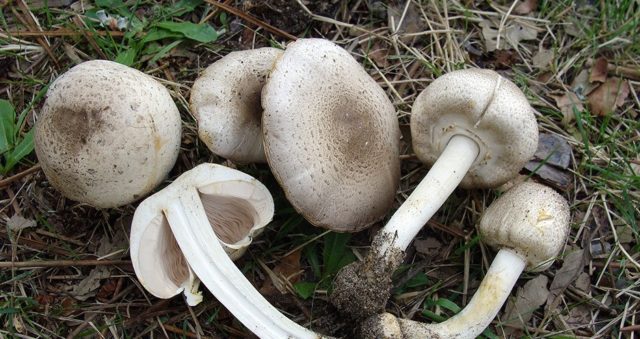Content
Champignons are considered the most popular and famous mushrooms in the world, but not all varieties of this genus can be eaten. One of these is the variegated champignon - a representative of the Champignon family, best known as the Möller champignon. It is considered a poorly studied and rare specimen, classified as an inedible mushroom.
What does motley champignon look like?
The hat of this type is convex, the size varies from 5 to 15 cm. Most often it is painted in a light ocher or cream color. On the surface of the cap there are wide scales of a smoky gray or brown hue. There are plates under the cap, the color of which depends on the age of the mushroom. So, in a young specimen, they are pale pink, then gradually acquire a dark brown hue.
The mushroom has a leg 6 to 10 cm long and 1 to 1.5 cm thick, with a large ring and an inflated base. Its lower part is covered with flaky scales. In a young champignon a variegated leg is painted white, in an older champignon it is yellow, and an old specimen is given a leg of brown color. The flesh of the champignon is of a variegated white color; on the cut it becomes brown. It emits an unpleasant odor, reminiscent of the smell of rubber. Spores are broadly elliptical, 5.5 × 3.5 μm. Dark brown spore powder.
Where does the motley champignon grow?
The variegated champignon prefers a temperate climate. Most often it grows in mixed and deciduous forests, in gardens and parks, as well as in meadows. It is located on fertile, often alkaline soil. As a rule, it appears from the second half of summer in small groups. It is quite rare.
Is it possible to eat variegated champignon
This species is classified as a poisonous mushroom, although its toxicity has not been noted in some reference books. Nevertheless, the variegated champignon is considered to be inedible due to its unpleasant odor and possible negative consequences.
Poisoning symptoms
Eating variegated champignon in food can cause poisoning, its main symptoms are as follows:
- diarrhea and vomiting;
- headache;
- increased body temperature, chills;
- pain and cramps in the stomach;
- increased sweating.
First aid for poisoning
At the first signs of poisoning, it is necessary to eliminate the poison from the body as soon as possible. For this, it is recommended to take an absorbent or drink a couple of glasses of salt water and induce vomiting. This procedure must be repeated at least 2 times. You can use an enema to cleanse the intestines. After providing first aid, the victim must go to the hospital for full treatment in order to avoid serious problems in the future.
Conclusion
The variegated champignon is quite easy to confuse with its edible congeners.If the mushroom picker doubts the choice, then a thermal test can be performed. To do this, you just need to dip an unfamiliar specimen into boiling water. If, after immersion, the water acquires an orange hue, exudes a sharp and unpleasant aroma, it means that a rather rare and poisonous Miller has been caught by the person. You should know that even after heat treatment, toxic substances remain in it, which can cause poisoning within 2 hours after its use.











